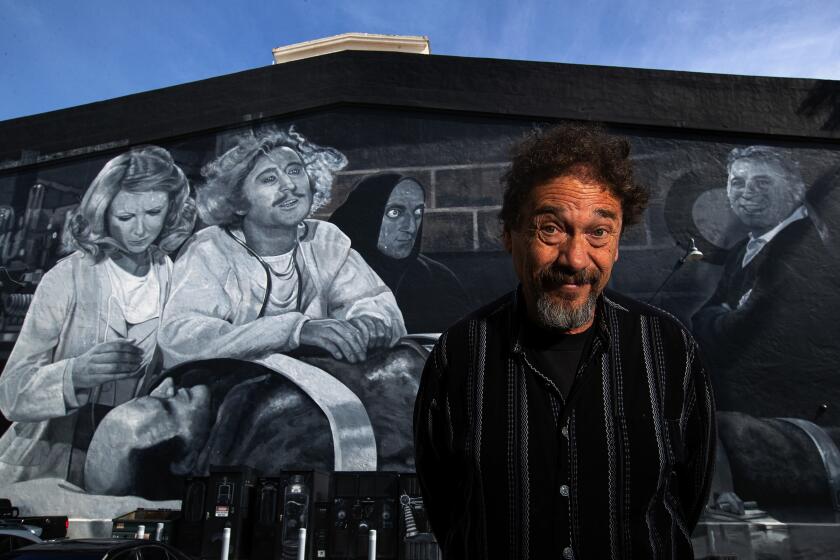How 200 historic Hollywood backdrops were saved from the dumpster

On top of a hill in Valencia, where the wind blows most days, the buildings are big, new and absolutely nonforthcoming. They could house anything — a doctor’s office, a car dealership, a secret government agency. Inside one, against the back wall, lies a pile of large equally nondescript pieces of canvas. Most are long and tied up with string; some have been folded into thick squares and stacked. They could be anything — enormous window treatments or very thin floor coverings.
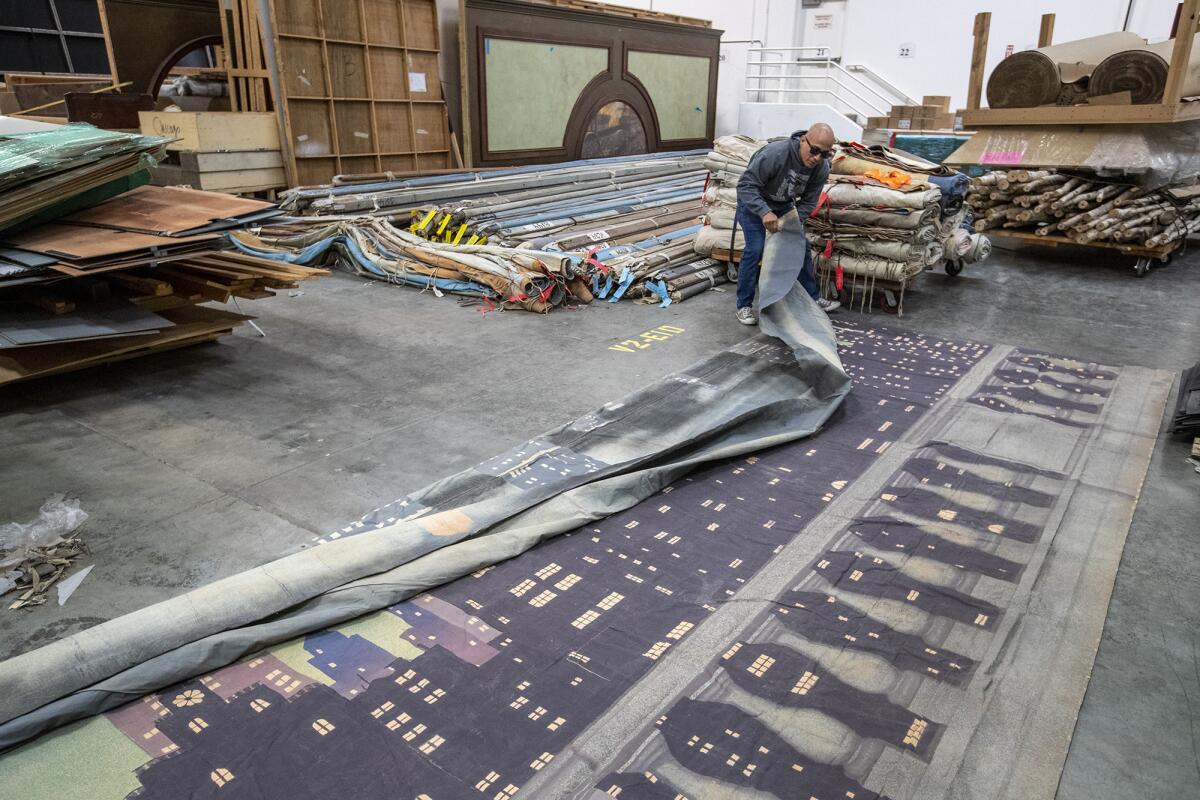
Until they are unrolled and reveal ... the world.
For the record:
3:56 p.m. Jan. 6, 2020This article says several backdrops went to the Royal Scottish Academy. They went to the Royal Conservatoire of Scotland.
Hillsides, houses, airports and cathedrals; cityscapes, landscapes and the ocean rocking toward the horizon; courtrooms and bedrooms, bungalows and castles; gas stations, skyscrapers, apartment buildings; the roofs of Paris and New York, corridors, tapestries, train depots and a mineshaft burrowing into an icy mountain.
The magic of Hollywood, in a Valencia warehouse, rolled up and waiting to be claimed.
These are the 90 painted backdrops that remain of more than 200 saved through the Art Directors Guild Backdrop Recovery Project, a two-year attempt to keep a relatively few pieces of irreplaceable art and Hollywood history from the fate of so many sets, props, costumes and backdrops: the studio dumpster.

“Hollywood started as a green industry and then became brown,” says former ADG president and Recovery Project founder Tom Walsh. “Everything was used repeatedly; nothing went into storage. Then when studios began to decline, they got rid of everything, sold things in auctions or just threw them away. And the first to go were backings. We will never know how many were lost, and if I go down that road I will just start to cry.”
“These, though,” he says, “we were able to save.”
There is no more iconic Hollywood image than the backdrop. Backdrops, or backings, are the enormous paintings that make the movie and television industries possible by stretching the confines of a studio set into endless possibility. With a good backdrop, western plains can stretch to the horizon, snowy peaks of mountains create the suspense of dizzying heights, jungles bloom, skyscrapers loom and cities wink through apartment windows. Sets cradle the action; actors, writers and directors create characters and drama; but backdrops build worlds.
Many are imprinted on our collective memory — the Georgian sunset against which Scarlett O’Hara vowed never to be hungry again, the island beaches of “South Pacific,” the view of the Danube from the Von Trapp family’s terrace in “The Sound of Music,” Mt. Rushmore in “North by Northwest.”
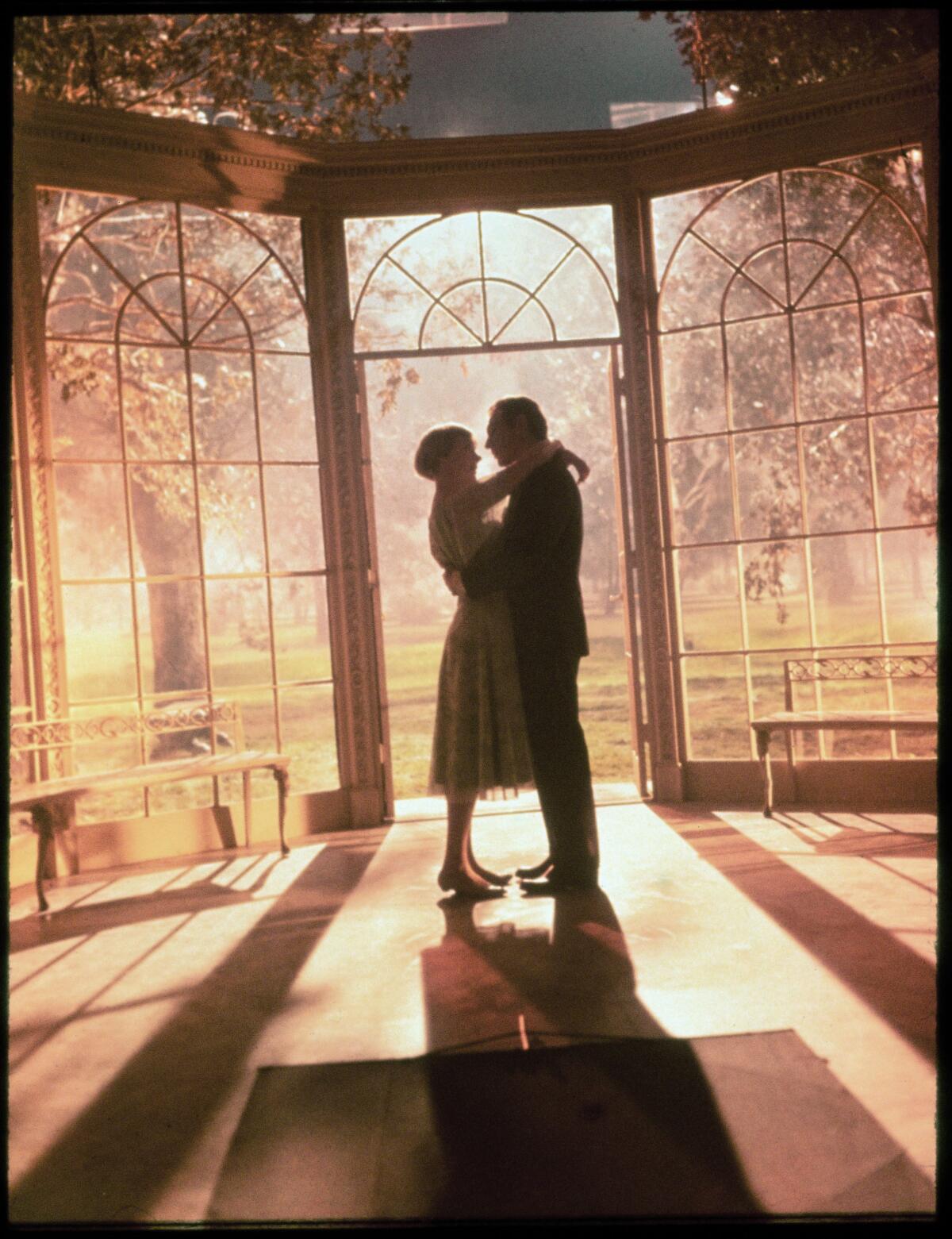
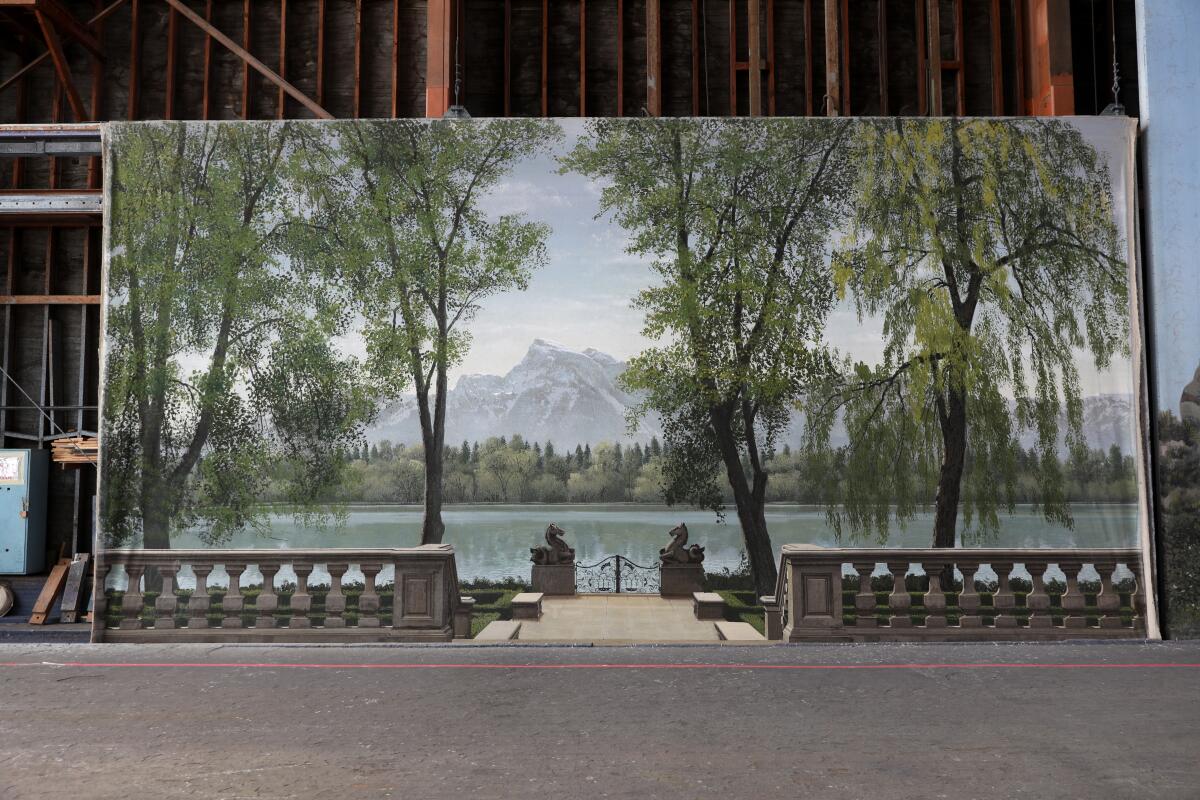
In the early years of Hollywood, studios hired artists to paint their own backings, which were sometimes used repeatedly and sometimes thrown away, depending on need, space and the studio’s financials. In the 1950s, a few scenic artists realized this was not a great system, that studios somehow sharing backings might work better, and a few artists began striking out on their own, painting and purchasing various backdrops they would then rent out.
Nowadays almost all backings, painted and otherwise, are furnished by rental companies.
JC Backings is one of the best known of the now handful of rental companies with the most notable collection of historic backdrops in the business. A business that has increasingly shifted away from painted backings to photograph and digital versions. Over the years, JC Backings has regularly, and out of necessity, culled its collection. Even when rolled or folded, backdrops are big, difficult to move, and require temperature-controlled storage. Those not making money as rentals are literally just taking up space.
Two years ago, President Lynne Coakley decided the company no longer needed 207 of its older backings. But this time, instead of filling up an oversize dumpster, she donated them to the Art Directors Guild, which unrolled, photographed and cataloged each one, and then set about finding each one a home.
Most of the more famous images went quickly. The film academy took the backdrop from the “Fit as a Fiddle” number in “Singin’ in the Rain,” the eerie landscape of “Forbidden Planet,” the tapestried walls of “Marie Antoinette,” the office from “Adam’s Rib.” Others, like the Sistine Chapel from “The Shoes of the Fisherman” were given to colleges; the Autry Museum of the American West has eight (including two from the 1947 Katherine Hepburn/Spencer Tracy Western “The Sea of Grass”) and a few went to the Royal Scottish Academy. (George Gibson, the legendary head of MGM’s scenic design department, where many of the backdrops were painted, was Scottish.)
Mike Denering’s brushstrokes are everywhere as one of Hollywood’s last scenic painters. He’s tried to retire, but the movies keep drawing him back.
In their new homes, the backings function in a variety of ways — as exhibits, teaching tools and occasionally theatrical backdrops, but all, including the ones still in storage in Valencia, mark another important shift in Hollywood. For many who work in the cinematic crafts, the real tragedy of the digital revolution and the end of the studio system has been the loss of so many iconic props and artworks. Now, as more studios are dismantled, absorbed or re-purposed, there is a growing demand that the working assets of old Hollywood, be they research libraries, backdrops or remainders of sets, be preserved.
A shocking phone call
In the short version of the story, the Backdrop Recovery Project began with a phone call. In 2017, Walsh was working in New Mexico as production designer on the Netflix western series “Longmire” when he got a call from Coakley.
She said: “Well, Tom, we’re going to move.”
He managed to not drop the phone, but it was a big and upsetting announcement. JC Backings was founded by the Coakley family, which has been part of the scenic art world for five generations. Over the years, the company acquired the collections of MGM, Universal, 20th Century Fox, Disney and Paramount.
For 40 years, the company operated out of the famous MGM scenic paint studio on what is now the Sony lot in Culver City and had a history with the studio for even longer. Lynne’s great-grandfather, John Coakley, was a scenic artist there, working under Gibson’s tutelage, when, in 1936, he fell to his death from a studio scaffolding. MGM’s method of compensation was to hire his son, John Harold Coakley, as an apprentice. John Harold eventually went to 20th Century Fox and, after “Cleopatra” nearly bankrupted the studio, he bought its backdrop collection. In 1962, he formed JC Backings with his son, John Gary Coakley.
In 1972, the company moved to MGM and its still gold-standard scenic studio.
JC Backings remains in the painted backdrop business — a backing from the 1958 musical “South Pacific,” for example, was recently used on an upcoming Netflix series and several equally venerable backings were recently rented for new Marvel projects (none of which Lynne can name because she signed nondisclosure agreements). But at least half of the company’s inventory is photo and digital, and it made no sense to pay for the MGM studio, which was built for painting scenic backings and did not have the storage space the company needed.
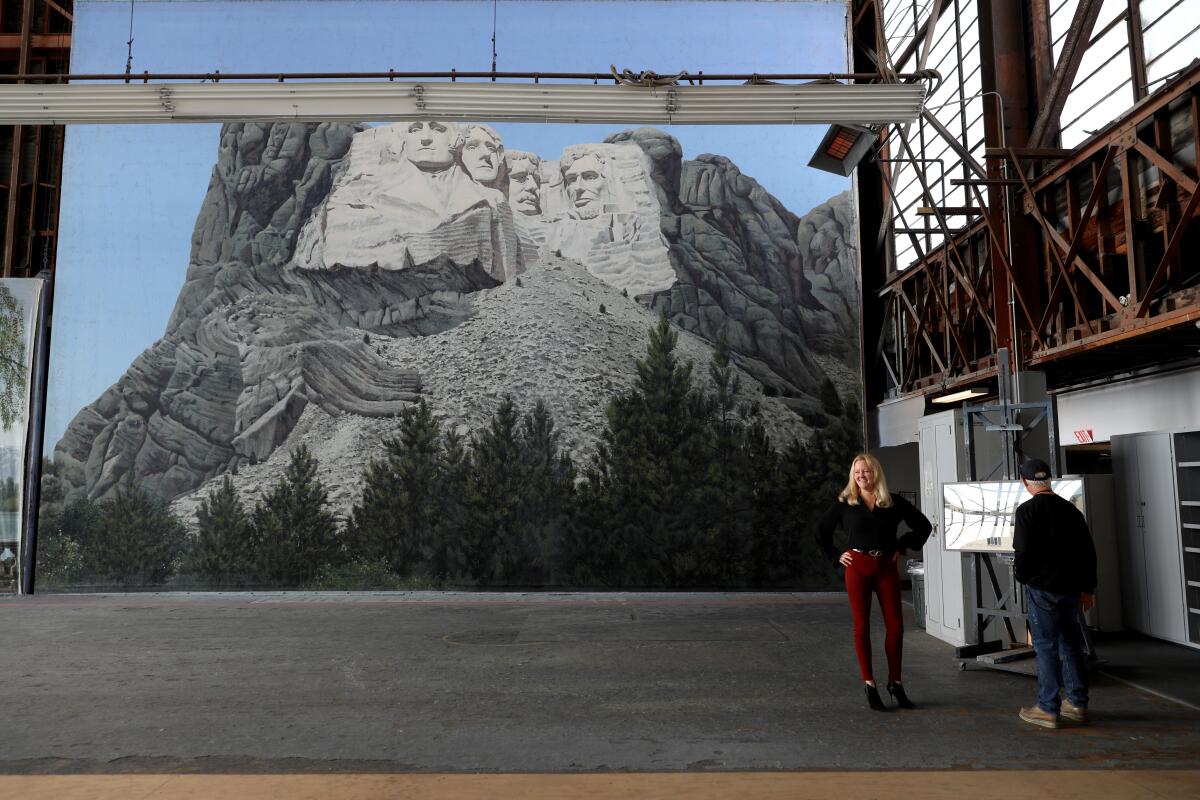
When Lynne Coakley decided to move the headquarters to a larger facility in Culver City, with a warehouse equipped for painting in Gardena, she eyed the 3,000 or so painted backings in the company’s collection and realized that more than 200 of them had not been used in years.
A decade ago, she says, she would have just chucked them; some were faded or damaged, some so specific they could never be used again.
“It’s only in the last 10 years that we’ve started thinking of them as having historic value,” says Coakley. “For years, we thought of backings as a commodity; that’s our business.”
In the long version of the story, the conversation that resulted in the Backdrop Recovery Project occurred almost 10 years ago.
An award-winning production designer, Walsh had worked with JC Backings for much of his career. As president of ADG, from 2003 to 2013, he was committed to making the public aware of scenic artists and preserving the historic work that remained. “I started as a pot boy,” he says, referring to the young workers who mixed the paints that scenic artists used for backdrops. “It was the last days of the old ways, and ever since then, I have a soft spot for scenic artists.”
And not just as a preservationist. Walsh believes that old Hollywood arts are crucial in developing the new ones and bemoans the fact that many cinema schools now view scenic painting as an elective for their arts programs.
“A lot of people are going into the digital arts,” he says, “but the best artists I’ve worked with, digital or not, are the ones who can pick up a pencil, who can look at something and see it before they start re-creating it. No matter how they do it.”
In 2012, he founded the ADG archives, which contains resources gleaned from old studio research libraries — books and photos, paintings and advertisements, anything and everything that could help artists of all types make the sets, props and backings beautiful and believable.

That same year, he approached Lynne about publicly displaying some of the iconic backdrops and the small paintings from which they were created; over seven years, the ADG and JC Backings co-hosted five open-house nights at the historic MGM studio.
The events were so popular, Walsh says, that he wondered if there was a book to be done. While giving a guest lecture at the University of Texas, Austin, he had met Karen Maness, a former scenic artist who loved backdrops almost as much as he did.
“I grew up in San Diego,” Maness says, “and I fell in love with all the murals in Los Angeles. When I saw my first theatrical backdrop, I knew this is what I wanted to do: I wanted to work big.”
She had been teaching theatrical arts at UT Austin for several years when Walsh approached her about doing a book, and she immediately said yes. “It was a passion project to understand these artists, to help them be seen for their work.”
For the next four years, she and Richard M. Isackes interviewed Hollywood masters and in 2016 produced “The Art of the Hollywood Backdrop,” a gorgeous doorstop of a book that tells the story of an art form that is at its best when it does not appear to exist.
“The publisher said it was the most beautiful book they had ever made,” Walsh says. “Certainly it is the heaviest.”
“Tom saw the urgency,” Maness says. “A lot of the artists we interviewed for the book are gone now, and I am so grateful that I got to speak with so many. It’s changed the way I paint and think about painting. I have never seen painting with such sensitivity to color, temperature and value structure. I am so embarrassingly in love with it.”
The Coakleys and their unique collection are a big part of “The Art of the Hollywood Backdrop,” in which the family’s story was told publicly for the first time. Lynne’s parents are, she says, very private and reserved individuals. Working with Walsh and Maness, Lynne began to think of JC Backings’ collection of painted backdrops as something more than company assets.
“After the book came out,” Walsh says, “we started hearing from a lot of people who were also interested in preservation.”
During the early years of the backdrop exhibitions, Lynne had been surprised when Anne Coco, the motion picture academy’s graphic arts librarian, had asked if she would be willing to donate some of the small paintings done as blueprints for the backings, which she happily did. So when Lynne decided there was no point in moving the 200-plus backings that were no longer in use, she called the academy first.
“The academy took about a dozen right away,” Lynne says. “The cream, obviously. The rest went to the ADG, and,” she adds laughing, “Tom got them to take about 10 more.”
Although the academy will not reveal anything about how, or which, backings will be displayed in its new Museum of Motion Pictures, Walsh says he put together an exhibit for architect Renzo Piano and his staff when they were in the designing phase.
For the remaining 207, she called Walsh, who was thrilled.
Thrilled and a little daunted. Moving more than 200 backings, some of which are more than 30 feet wide and, affixed to wooden battens, weigh several hundred pounds, is no joke. Nor is the work of unrolling each one and trying to identify the films for which it was used. Especially when you have only a couple of weeks to do it.
“There were some of backings that hadn’t been opened,” says Maness, who, along with a dozen or so ADG members, helped with the moving and cataloging. “The reason they survived when so many assets were lost or sold off in auction was that they were able to keep them at MGM so they were up and out of sight.”
But if the three weeks it took to catalog and move the backings were difficult, they were also exhilarating. There was gold in them there rafters.
“No one knew the ‘Fit as a Fiddle’ backing was in there,” says Walsh. “Or the tapestries from ‘Marie Antoinette.’ And the ‘Forbidden Planet’ landscapes were so amazing. But even the ones that weren’t famous, are gems. If it weren’t for JC Backings,” he says, “this library, which dates back to the 1930s wouldn’t exist.”
He has spent the past two years finding homes for the original 207 and then an additional 65 donated by Scenic Express. As of publication, there are still 50 or so in the Valencia warehouse that he hopes will find homes at some film or theatrical school. The University of Texas, Austin took 47, including the 24 from “The Shoes of the Fisherman,” which Maness uses to teach painting and design to her students; one of her classes is reproducing the Sistine Chapel.

Saving the lost art of Hollywood
“Everything you need to know about how to paint is in those backdrops,” she says. “I recognize that we are living in a digital world, but there’s so much power in the painting.
“After the book came out, it raised consciousness about preservation. Photographic backings are fine — I use them, we all use them — but painted backdrops are art. Some are so simply drawn that when you look at them closely they don’t look like anything.
“And then you step back and you see the world.”
More to Read
The biggest entertainment stories
Get our big stories about Hollywood, film, television, music, arts, culture and more right in your inbox as soon as they publish.
You may occasionally receive promotional content from the Los Angeles Times.
